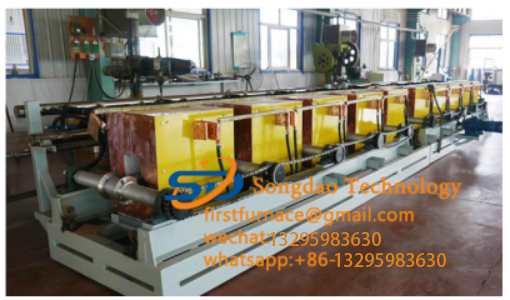- 07
- Jan
Application of quenching heat treatment process of intermediate frequency heating equipment
Application of quenching heat treatment process of intermediate frequency heating equipment
Relying on its special heating principle, the intermediate frequency heating equipment realizes environmental protection, energy saving, high efficiency and other production during the processing process. At present, it is very popular among heat treatment manufacturers in the mechanical processing industry.
විට intermediate frequency heating equipment is used in the heating of metal quenching heat treatment, the carbon content of the workpiece of different materials mainly depends on the change of the carbon content. The distance between our matching induction coil and the workpiece should also be slightly adjusted. The simplest identification method is the quenching spark identification method when the intermediate frequency heating equipment is working. Check the sparks of the workpiece on the grinding wheel. You can roughly know whether the carbon content of the workpiece has changed. The higher the carbon content, the more sparks. .
Another scientific method of identification is to use a direct-reading spectrometer to identify the composition of steel. A modern direct-reading spectrometer can inspect and print out various elements and content of the workpiece material in a very short period of time to determine the steel. Whether it meets the drawing requirements. Excluding the carbon-poor or decarburization factors on the surface of the workpiece, cold drawn steel is more common. The surface of the material has a carbon-poor or decarburized layer. At this time, the surface hardness is low, but after 0.5mm is removed with a grinding wheel or a file, the hardness is measured. It is found that the hardness at this place is higher than that of the outer surface and meets the requirements, which indicates that there is a carbon-poor or decarburized layer on the surface of the workpiece.
Taking the workpiece spline shaft as an example, when we use intermediate frequency heating equipment for quenching, the reasons for the uneven hardness after quenching may be as follows:
1. There may be a problem with the material of the workpiece, and the material may contain many impurities.
2. The process parameters are unreasonably determined during quenching.
3. The most likely occurrence is that the induction coil is made unreasonably, which causes the induction coil to be at different distances from the workpiece, resulting in uneven heating temperature and uneven hardness of the workpiece.
4. Check whether the cooling water circuit and the water outlet hole of the induction coil are smooth, otherwise it will cause uneven hardness.
When we apply intermediate frequency heating equipment to the quenching heat treatment process, we must also pay attention to a problem: the quenching heating temperature is not enough or the pre-cooling time is too long. If the quenching heating temperature is not enough or the pre-cooling time is too long, the temperature during quenching will be too low. Take medium carbon steel as an example. The quenched structure of the former contains a large amount of undissolved ferrite, and the structure of the latter is troostite or sorbite.
Furthermore, when we apply intermediate frequency heating equipment to the quenching heat treatment process, insufficient cooling is also a big problem! Especially during scanning quenching, because the spray area is too short, after the workpiece is quenched, after passing through the spray area, the heat of the core makes the surface self-tempering again (the large step of the stepped shaft is most likely to be generated when the large step is in the upper position), and the surface is self-returning. The fire temperature is too high, which can often be sensed from the surface color and temperature. In the one-time heating method, the cooling time is too short, the self-tempering temperature is too high, or the cross-sectional area of the spray hole is reduced by the scale of the spray hole, which causes the self-tempering temperature to be too high. The temperature of the quenching liquid is too high, the flow rate is reduced, the concentration changes, and the quenching liquid is mixed with oil stains. Partial blockage of the spray hole is characterized by insufficient local hardness, and the soft block area often corresponds to the blockage position of the spray hole.

